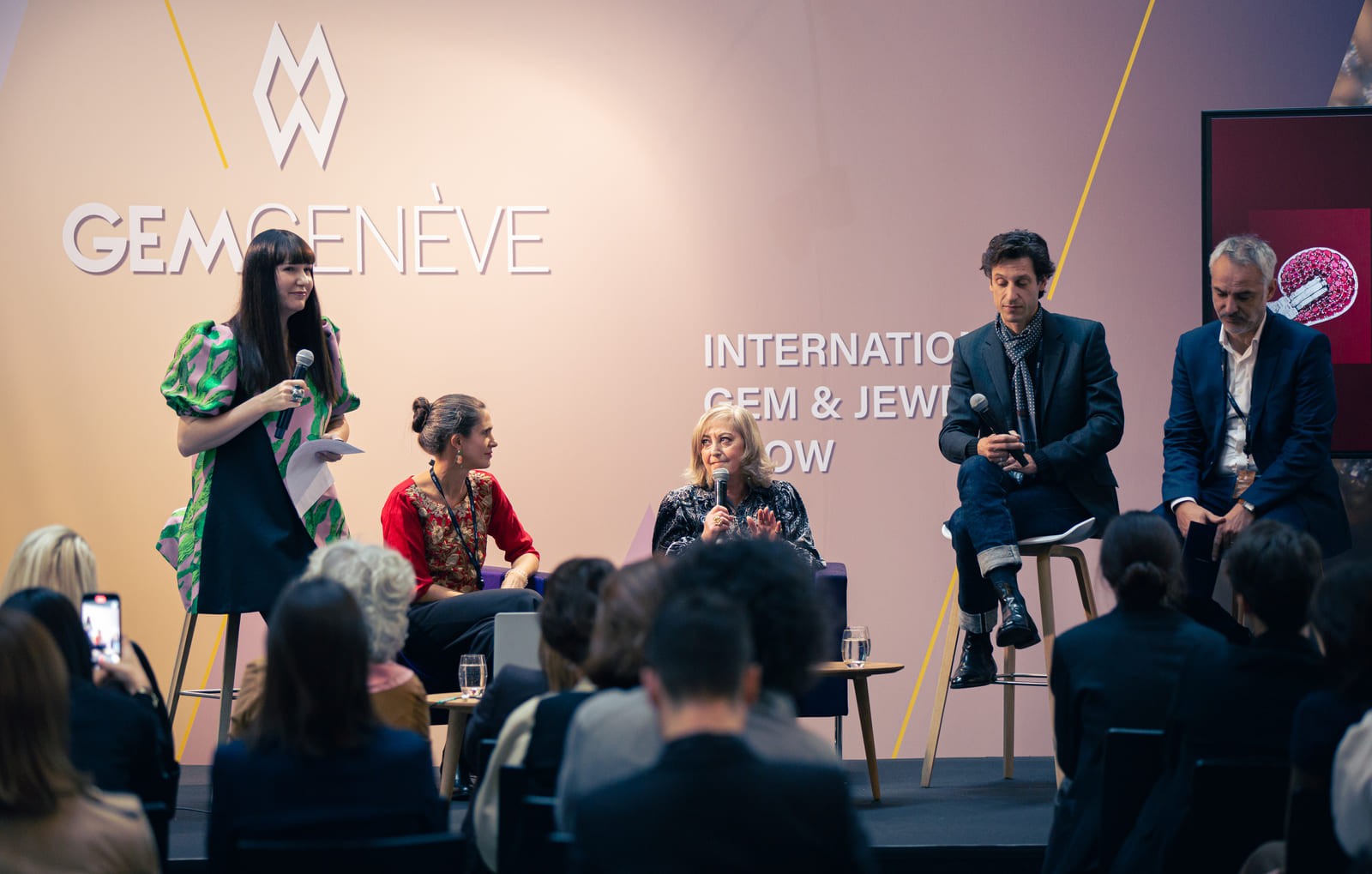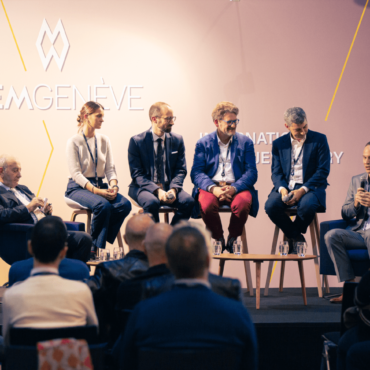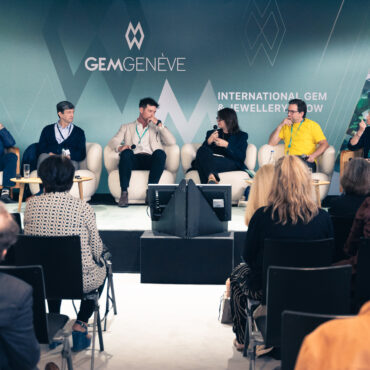Panel discussion moderated by Katerina Perez (influencer), with David Roux-Fouillet (Head of the Department of Product Design, Jewellery and Accessories, HEAD Geneva), Olivier Bachet (expert), Vivienne Becker (jewellery historian, author) and Alix Dumas (Designer)
Sometimes we look at a piece of jewellery and we fall in love with it instantly and sometimes, you have to heavily market a design or a collection in order for it to sell. What is that “magic formula” that makes the jewellery design exceptional?
Jewellery that makes your heart beating faster
It is a jewel that really captures its moment in time, which reflects what is going on in the world around it. A jewel that combines the design expression with superb craftsmanship and wonderful materials. And a jewel able to combine a certain “newness” to echoes of the past – which make it even more fascinating.
For example, Modernism in jewellery reflected the world as it was evolving. Today, Fabio Salini stands for the Modernist style. He is considered a modern head of “new Modernism” thanks to his very graphic simple compositions of colours, lines and forms. Another example is Alexandra Jefford: her jewels have something original to say. So, it is not so much about some kind of surface stylism, but more about a meaningful message.
Another trait of Modernism is the ability of reinterpreting old motifs, like Philippe Loras and his ribbon bows, or again Elena Okutova, who has been able to revive Russian jewellery art to tell stories that combine history and modernity.
Modernism today is not only about themes, but also about techniques, as with Boghossian.
They indeed took very traditional skills and techniques and modernized them to propose beautifully crafted pieces.
Jewels can make our hearts beating faster when the convey an emotion, a poetic vision, as in the example of JAR, who derives his inspiration from nature and translates it into an emotional, poetic vision of jewellery.
One this is for sure: exceptional design does not always have to be overly complex; it doesn’t have to be a huge flower with tons of pave and a big gemstone in the centre. It can be something simple but at the same time when unusual techniques are used, these make it truly exceptional.
What does us make falling in love with a jewel?
When we see a piece of jewellery, do we fall in love with it because of emotions or because of other factors, like an important gem or the investment side of it?
For many, the first factor at work to fall in love with a jewel is the emotion.
Jewellery is not something we need; it is something we want. In that sense designing a piece of jewellery is like drafting a poem. The jeweller has all sorts of different tools that he can use: the choice of materials, of curves, shapes, details, colours, and stones. All these are like words that a writer uses to create a sentence that hopefully will touch not just for its technicality and the beauty of its structure, but for the emotions it evokes.
There is an element of magic in jewellery which relates to its origins as a magical, amuletic object. We fall in love with a jewel because we respond to jewellery on a very atavistic level, responding to the storytelling and the emotion that jewel generates in us.
One thing to notice is that we could fall in love with a jewel, but not wanting to wear it. We could, for example, admire Lalique and his Art Nouveau marvellous jewels, but we could never see ourselves as wearing any of these. Also, there might be a jewel we loved in the past, and that do not like so much at present – our taste keeps evolving in time, and our love with jewels goes with it.
Taste is something personal, and in front of two jewels interpreting the same motif, the reactions, the preferences could be each time different. There is no right or wrong when it comes to liking a jewel according to one’s personal preference.
What contributes to the beauty of a jewel?
There are several aspects to consider.
Oscar Wilde famously said that “Beauty is in the eye of the beholder”. The beauty of a jewel is made up of many elements, such as the pure emotion it elicits, its craftmanship, the proportions, colours, the volume and all the details of the design.
Colour is the emotional trigger; everyone responds to distinct colours in diverse ways.
Everyone also respond to a gem’s inner light – this is something that has captivated humankind for thousands of years, so colours and light are an emotional key to the beauty of a piece of jewellery.
When we speak about proportions, if a jewel is designed and worked as a piece of art, as a sculpture, the jeweller becomes an artist who, through his/her sensitive eye will re-adjust volumes and proportions. It is an artistic instinct that helps the jeweller-artist to reach a golden ration that makes the jewel perfect.
We all are still sensitive to the way jewels are made. Artisanship makes the difference: even if colours and proportions are nice, at the end it is the way the piece is made that counts, and this is also why some brands are known for the quality of their craftsmanship. It is part of jewellery emotion: a beautiful piece of jewellery must also be well made.
The excellence can then be reached when craftsmanship disappears, so that you don’t notice it at all. This happens when craftsmanship is at the service of the design, the concept, the little details, and the comfort in wearing the jewel. All these qualities are there, but you do not see the craftsmanship and the savoir-faire beneath it.
Jewels we love & storytelling
Does storytelling contribute to making us fall in love with a jewel? Is it important, when we buy a piece of jewellery, to know about the inspiration behind it, how the designer produced that idea?
The story behind a jewel helps to connect with the jewel itself. In many instances people would buy a piece of jewellery because the story speaks to them – for example, it might happen that they buy a ring which is inspired by the sea and they love surfing; or maybe they have travelled to a destination which is in their memory and the piece of jewellery is inspired by such location.
Storytelling, to connect to the jewel, should be authentic. The story, the theme or the inspiration should be authentic to the designer. This will create that sense of harmony that will make this connection between the person and the jewel click – because we instinctively know when a story is authentic, and when it is not.
Jewels contribute to self-expression, today as in the past – this has not changed. Some of us will choose classic or antique pieces, while other will go for avant-garde and contemporary designs.
The expressive power of a jewel goes through the body of the wearer. There is a tactile element attached to the jewel, a jewel should be felt. This is as important as the storytelling and the technical elements behind the creation.
Designer DNA or brand to define an exceptional design?
One big question when it comes to jewellery design is the following: is it important to be different and show your own personality in what you create, or is it better to think of what the client wants and create something that will fit his/her taste?
There is not only one answer. If you choose to be an artist, you have a view for each single creation, you communicate through pieces which may be very organic, others that may be very geometrical. It is not about being included in a closed cycle, sticking to “style guidelines”. It is more about the ability of expressing a message. The DNA of the artist can of course be present through a sort of “red line” that defines the artist’s personality, its evolution in time.
One specific DNA imprint can reveal the jewellery designer to the eyes of customers. It is not only about techniques and languages, but it is also about a way of thinking about the world.
It is a journey for the jeweller to find him/herself, his/her true voice and to express a vision of the world, a message, through jewels – this is an aspect that keeps evolving together with the evolution of the designer’s inner world. An aspect that is not easy to define and streamline.
For example, a designer might fall in love with the theme of the wave. Being an artist means to interpret the theme in different ways, producing pieces that refer to the theme having a uniquely different look and personality. An artist rarely works on collections – they are repetitive and work in series, something a jewellery artist could never do.
Another crucial difference is on budget. A jewellery artist would start with the design and then would assess the budget to produce it. A brand would go the other way round: they would often start from a given budget and would try and produce the collection.
The goal is, of course, sales. Whether a jewellery designer is guided by a strong inspiration, or by brand collections, the final objective is to sell amazing jewels through the right channels to the final consumers.
Where does exceptional design start from?
It is not only a strong idea to guide the creative process. In many cases, the intricate beauty of a stone commands the entire design of a jewel. It can take sometimes months, or even years, before that gem finds its place in a jewel, but it is for sure worth the wait – a gem has its story to tell, and it cannot be dispersed in an undistinguished design.
An exceptional design can also start from the material – metals, or a piece of wood have their own story. In this case it is about experimenting, working around them to understand their language and translate it into the body of the jewel. From here a new storytelling starts.
Therefore, no matter where you start from, linking the creation to a meaningful idea, to an exceptional stone, to unusual materials (or all of these at the same time) will let the world admire an exceptional jewellery design.





